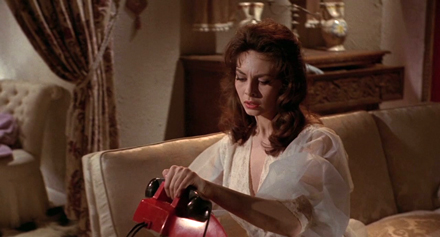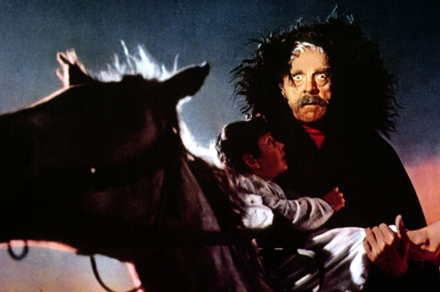
 |
|
|
|
The widespread appreciation of the great Italian director Mario Bava really didn't happen until complete original versions of his work began to emerge on DVD. The started with a series of Image Entertainment releases late in 1999. Since then we've been treated to improved editions, eventually topped by an exhaustive, epic-length film book on Bava by Tim Lucas, the editor and publisher of Video Watchdog. My own interest in Bava began with a late-night TV screening of Black Sabbath in around 1967, but I didn't see Black Sunday until college, and that was in 16mm. A midnight Westwood screening of a glorious Technicolor print of Danger: Diabolik sealed the deal for this fan. Bava films were a frequent topic of discussion with friend and colleague James Ursini, who with his writing partner Alain Silver wrote one of the first English-language academic-level articles on Mario Bava, for the magazine Photon in 1975. From then on, the major difficulty with classic Italo horror was finding quality copies to view. 
Definitely one of the high points in Italo horror is Bava's Black Sabbath (I tre volti della paura), a title that by now is familiar to most horror fans over the age of twenty. Clearly impressed by the box office performance of Black Sunday, American-International eagerly involved itself with Bava's follow-up, an intense exercise in gothic horror that put Bava's utterly fantastic color cinematography to the ultimate test. Whereas the American market for horror was a genre ghetto, and forced to cater to the juvenile matinee crowd, in Europe Bava's work was appreciated on an adult level. Industry professionals that had respected Bava's camera and special effects work now saw him as a director of high quality. As documented so thoroughly by Tim Lucas, even director Federico Fellini was deeply influenced by Bava's haunted visions. Black Sabbath became a hit in America as well, re-cut and re-dubbed in English. Star Boris Karloff was still very much a major marquee draw. Although he appeared in a dozen more fright films, Karloff's memorable role here may be his last 'classic' movie horror character. Kino's presentation is actually I tre volti della paura, the original Italian version of Black Sabbath with an Italian-language soundtrack. It's an omnibus film composed of two short story-like exercises and another longer essay in screen terror. In The Telephone a woman (Michelle Mercier) becomes unhinged by phone calls from a dangerous ex-lover. The Wurdulak is Boris Karloff, who returns from a ghoul-hunting mission to threaten his entire family with the curse of vampirism. And A Drop of Water is a poetic, creepy essay about a nurse (Jacqueline Pierreux) who steals a ring from the wrong corpse - a clairvoyant who died in mid-séance. The three stories vary in tone and content. The Telephone is very much a proto-giallo picture, a claustrophobic suspense piece restricted to a young woman's apartment. We enjoy watching Michelle Mercier disrobe -- Bava's images enhance the effect by drawing attention to the contrasting textures of her clothing. Threatening phone calls slowly reduce Mercier to shivering panic, as first another woman arrives, and then the cruel ex-lover himself. It's widely known that A.I.P. used its re-dubbing job to essentially re-write the episode, losing a lesbian subplot to make the film matinee-friendly. 
The Wurdulak was repositioned to come last in the American cut, which made sense because it is the longest episode and the one that stars Karloff. It's a classic vampire tale that shows an entire clan wiped out by a father figure. The family unit has no defense against the vampire because he uses his traditional position of respect to demand their obedience - and submission. 'Family ties' bait the trap again and again, until a woman kills her own husband because he won't open the door for their little boy - who by this time is almost certainly a vampire as well. Karloff is terrific as the brooding, bellowing paterfamilias. By 1963 he was having difficulty getting around, yet puts quite a bit of himself physically into the role. It's obvious that he believes in what he's doing. The Wurdulak slows down a bit as Mark Damon and Suzy Andersen attempt a hopeless escape from the clutches of her relatives. What we most remember are the faces given Bava's stylized lighting treatment. This episode has the most thematic depth: the idea that "Family" is a weakness against supernatural evil goes against conventional horror tradition, and is all the more disturbing for it. A Drop of Water is the story that really frightened young viewers in 1963, as it marshals sound and image in the manner of a great horror short story. The thieving nurse is haunted by dripping taps (amplified with close-up images and sound effects) and creepy images like an insect landing on a corpse's finger, where a stolen ring once was. The enormous interior of the medium's apartment, with its fallen drapes and wandering cats, is an atmospheric cave of mold and decay. At first sight the frozen head of the dead medium with its staring eyes seems overdone, but when the feeling of panic accelerates to the right pitch, the episode is every bit as affecting as Poe's The Tell-Tale Heart. Viewers that remember the A.I.P. release will of course notice some major alterations. American International changed the order of the stories, added more Thriller-style Karloff intros between them, and did their usual music swap-out. As in Black Sunday, they jettisoned Roberto Nicolosi's varied and understated score for the more emphatic and obvious (but not bad) Les Baxter. Nicolosi's soundtrack is less homogenous. A series of subliminal hisses and tones underscores A Drop of Water, and some of The Telephone is appropriately backed by lounge music. 
The English-language voices on the A.I.P. re-cut had that distracting Sons of Hercules vibe. Seeing Sabbath with English subtitles is a real plus when trying to interest non-initiates. The only regret is that Boris Karloff is re-voiced in Italian with the rest of the international cast. It is possible that the whole show was filmed with the actors phonetically voicing English: Ms. Mercier and Pierreux in particular seem not to be speaking Italian under their dub jobs. It's difficult to properly express the 'special' quality of Mario Bava's artistic lighting. Other filmmakers occasionally attempt a similar look but few match Bava's intensity. Back in 2000 the first Black Sabbath DVD was one of the few discs that I'd revisit just to enjoy the impressive lighting effects. Bava would conjure these unique images within tiny budgets and short shooting schedules. Favoring bright primary hues, sets are bathed in washes of color that can only be called hallucinatory. Electric greens and crimson reds, steely blues and deep purples give the screen depth and character. The heroines are bathed in warm golds and lit in non-traditional ways that make them look lusciously alive (Mercier) or nervously cold (Pierreux). Suzy Andersen in The Wurdulak has the icy beauty of a Catherine Deneuve. In shambling silhouette, or choker close-ups, Boris Karloff's ragged vampire is not only his best-photographed color role, but also one of his finest performances - even when robbed of his distinctive voice. The fact that Bava's lighting makes frequent use of unmotivated, un-sourced colored lights only adds to the feeling of fantasy. Images disturb precisely because their lighting is so "impossible". In one of the last images of The Wurdulak three actors stare at us through frosty windowpanes. The faces are practically ear-to-ear, but each has its own distinctive lighting. How did that Bava do it? The likes of this kind of dramatic lighting haven't been seen since. 
Before Tim Lucas' book illuminated the depth and breadth of Bava's talent his visual style was often described as his only asset. The fact is that it alone would be more than enough. Little in these stories is conveyed in dialogue; Bava's directing is almost completely visual. The greedy nurse's fixation on the clairvoyant's jeweled ring, for instance, is neatly conveyed in furtive looks and matched compositions. The visual links between the ring and the (ghostly?) insect aid the jump from the natural to the supernatural. Kino Classics' Blu-ray of Black Sabbath is a nearly perfect encoding of this true classic of horror filmmaking. The images are sharper and more detailed than ever before. The increased contrast also pulls more out of Bava's beautifully recorded color images. The hues are nicely distinguished, differentiating the texture and apparent weight of objects on screen. The image does look a bit colder than the earlier transfer, which very closely mimicked the appearance of chroma-saturated Technicolor prints. Fans who want to recreate that exact feeling will be able to recreate it by adjusting their color settings a bit. The only extras on Kino's disc are some trailers for other Bava pictures. There is a new UK disc that includes both the Italian and American versions of Black Sabbath, but it's a Region B Blu-ray unplayable on normal U.S. equipment. The main attraction would be hearing Boris Karloff's original English language dub job, where he speaks for himself. But Les Baxter's replacement music track is not an improvement over the Roberto Nicolosi original, and the other editorial changes can get annoying. Everybody wants to be an editor in circumstances like this one. My idea of a great compromise disc of Black Sabbath would be to retain the Italian picture, music, and episode order. The interstitial introductions by Boris Karloff would be from the A.I.P. cut, in English of course. And then in The Wurdulak, Karloff would be allowed to speak in his own voice, with the subtitled Italian voices retained around him. Sounds like a solution to me, even if it scrambles film history.
On a scale of Excellent, Good, Fair, and Poor,
Black Sabbath Blu-ray rates:
Reviews on the Savant main site have additional credits information and are often updated and annotated with footnotes, reader input and graphics.
Review Staff | About DVD Talk | Newsletter Subscribe | Join DVD Talk Forum |
| ||||||||||||||||||